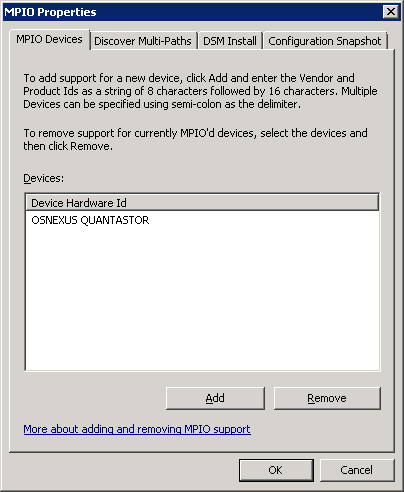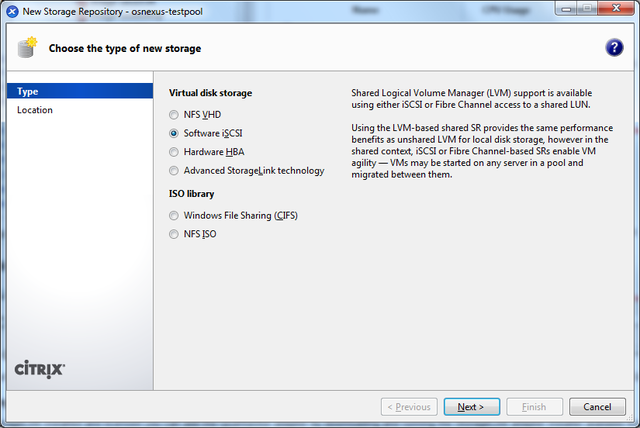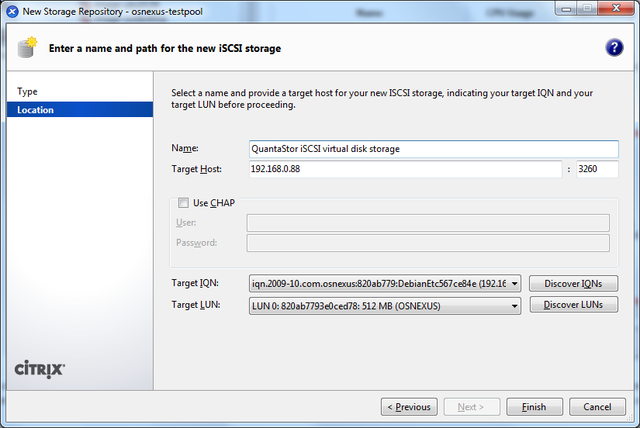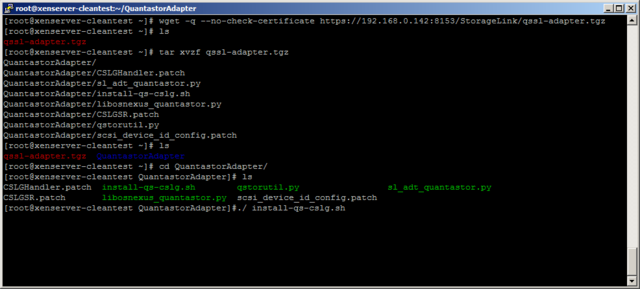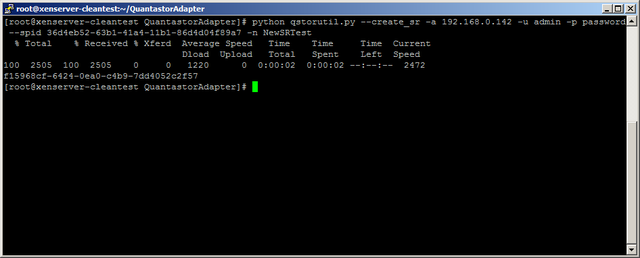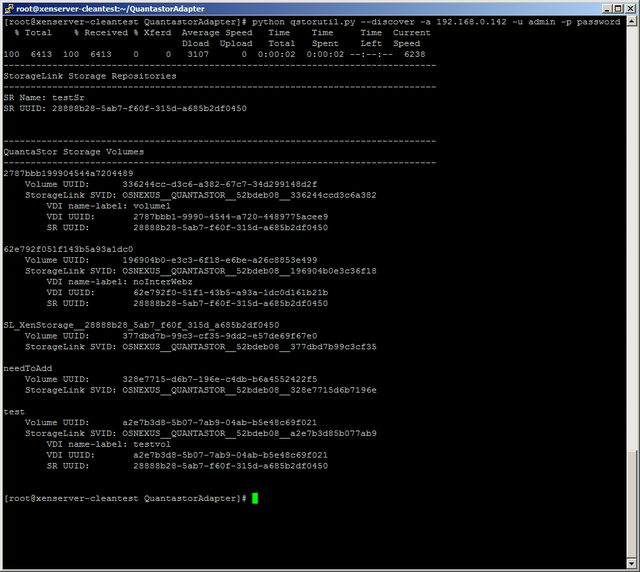Difference between revisions of "+ User Guide Overview"
m (→Installing the iSCSI Initiator service on the VSA) |
m (→Logging into the PSA target storage volume from the VSA) |
||
| Line 377: | Line 377: | ||
</pre> | </pre> | ||
| − | You have now logged into the storage volume on the PSA and your VSA now has additional storage it can access | + | You have now logged into the storage volume on the PSA and your VSA now has additional storage it can access to create storage pools from which it can in turn deliver iSCSI storage volumes, network shares and more. |
| + | === Verifying that the Storage is Available === | ||
| + | To verify that the storage is available you can run this command which will show you that your VSA now has a QuantaStor device attached: | ||
| − | + | <code> | |
| + | more /proc/scsi/scsi | ||
| + | </code> | ||
| + | |||
| + | <pre> | ||
| + | Attached devices: | ||
| + | Host: scsi1 Channel: 00 Id: 00 Lun: 00 | ||
| + | Vendor: VBOX Model: CD-ROM Rev: 1.0 | ||
| + | Type: CD-ROM ANSI SCSI revision: 05 | ||
| + | Host: scsi4 Channel: 00 Id: 00 Lun: 00 | ||
| + | Vendor: OSNEXUS Model: QUANTASTOR Rev: 300 | ||
| + | Type: Direct-Access ANSI SCSI revision: 06 | ||
| + | </pre> | ||
| + | |||
| + | === Troubleshooting === | ||
| + | |||
| + | If you had problems with the above you might try restarting the iSCSI initiator service with 'service iscsi-network-interface restart'. Do not restart the 'iscsi-target' service as that's the service that's serving targets from your VSA out to the hosts consuming the VSA storage. Note also that if you restart the 'iscsi-target' service by mistake you'll need to restart the 'quantastor' service to re-expose the iSCSI targets for that system. | ||
Revision as of 16:02, 3 April 2013
The QuantaStor Users Guide focuses on how to configure your hosts to access storage volumes (iSCSI targets) in your QuantaStor storage system. The first couple sections cover how to configure your iSCSI initiator to login and access your volumes. The second section goes over how to configure your multi-path driver.
Contents
- 1 iSCSI Initiator Configurations
- 2 Multipath Configuration
- 3 XenServer Configuration
- 4 Virtual Storage Appliance iSCSI Configuration
iSCSI Initiator Configurations
Microsoft iSCSI initiator configuration for Windows 7 & Windows 2008 Server
Connecting to your QuantaStor (QS) storage system via the Microsoft iSCSI initiator is very simple. Before connecting though you'll need to add a 'Host' entry for your initiator. To do so, login to QuantaStor Manager, select the 'Hosts' section and then choose 'Add Host' from the toolbar or right-click in the Hosts section and choose 'Add Host' from the pop-up menu. Next, enter the host name and the initiator IQN for your host. The initiator IQN (iSCSI Qualified Name) is an identifier that uniquely identifies your host to the storage system. By default this name is generated for you so you'll need to go to your Windows system and run the iSCSI Initiator application to get the IQN. The initiator name will look something like this: 'iqn.1991-05.com.microsoft:yourhostname'.
Note: The first part of the initiator name identifies the initiator vendor, in this case "iqn.1991-05.com.microsoft", the second part is typically your host name or the fully qualified domain name (FQDN) for the host (ex: yourhostname.yourdomainname.com). All IQNs start with 'iqn.' and IQNs have various restrictions on what characters you can use. So if you modify the IQN try keeping your changes to the host name portion of the IQN and only use alpha-numeric characters.
A software iSCSI initiator comes with Windows and you will find it under the 'Administrative Tools' section under the Windows Start menu. Once you have the 'iSCSI Initiator Properties' dialog loaded, choose the 'Configuration' tab and in there you'll see the 'Initiator Name:'. Copy & paste that IQN into the 'Add Hosts' dialog in QuantaStor Manager using the clipboard (Ctrl-C & Ctrl-V). Note that you must enter the IQN into the 'Add Hosts' dialog exactly as it is written in 'iSCSI Initiator Properties', if you make a typo then the host will not successfully login to the storage system. Now that you have a host entry in QuantaStor for your Windows host, you can now assign storage to your Windows system and access it from your windows box. After you have assigned one or more storage volumes to the host, return to your Windows system and bring up the 'iSCSI Initiator' application again. On the first page under the 'Targets' tab, you can enter the IP address of your QuantaStor storage system in the box marked 'Target:' then press 'Quick Connect...'. After a moment you will see your storage volumes appear in the 'Discovered targets' section. When they appear simply select the storage volume you want to connect to, then press the 'Connect' button. Within a few seconds you'll be connected to the storage volume (iSCSI target). Unless this is a storage volume you've previously formatted and utilized, you'll need to use the Windows Disk Management screen to quick format the disk before you begin using it.
iSCSI initiator configuration for Apple Mac OS X
We recommend using the ATTO Xtend SAN iSCSI initiator available here. We do not recommend using the globalSAN initiator as we have seen problems with it in testing.
Once you have the IQN for your OS/X system you'll need to add a host entry to QuantaStor using the QuantaStor manager web UI. Just press the 'Add Host' button and then enter the name of your system, and enter the IQN in the box that says 'IQN'. Now that you have a host added, you can assign volumes to your Mac. After you've assigned some storage, go back to the iSCSI initiator dialog in OS/X and enter the IP address of your QuantaStor system and you should immediately see all the storage volumes listed which you have assigned to the host. Note that you'll need to partition the disk after you connect to the iSCSI device / volume. We recommend that you use 'quick format' because a full format will end up reserving blocks in the storage system which defeats the purpose of using thin-provisioning which is the default when you 'Create Storage Volume'.
Multipath Configuration
QuantaStor supports round-robin style active/active multipathing using Microsoft's MPIO and via Linux using the device-mapper multipath (dmmp) driver. Active/active multipath support not only boosts performance, it also gives you the benefit of automatic path failover when a network connection is lost to one of your NICs on the host (initiator side) or the storage system (target side).
For Microsoft MPIO configuration you'll need to add the QuantaStor vendor / model information so that Microsoft's default DSM (device specific module) can detect QuantaStor volumes and automatically enable multipathing for them thereby combining multiple paths to your QuantaStor Storage System in a single device as seen in the Windows Disk Manager.
For Linux, you'll need to first install dmmp for your Linux distribution, and then modify the /etc/multipath.conf file to include an additional stanza so that the system properly identifies the QuantaStor devices and uses the correct multi-path device identification and path management rules.
Note: QuantaStor supports SCSI-3 Persistent Reservations so you can use it with Microsoft's Failover Clustering / Hyper-V and other cluster solutions that require SCSI-2 or SCSI-3 reservations.
Configuring Microsoft MPIO
The first step in configuring MPIO on Windows Server is to navigate to MPIO properties. (Note that desktop versions of Windows such as XP, Vista, and Windows 7/8 do not support MPIO, you must be using Windows Server 2003/2008/2012) The easiest way to get to the MPIO configuration screen is to type MPIO in the Start menu search bar. It can also be found in the Control Panel under "MPIO". Once you're at the MPIO dialog, select the "MPIO Devices" tab and then click the "Add" button. The string you will need to add for QuantaStor is exactly:
OSNEXUS QUANTASTOR
^ ^^^^^^
Note that the '^' characters are provided here so that you can see where the spaces are. Note also that these are all capital letters, with one space between the words, and exactly six trailing spaces after QuantaStor. If you don't have exactly (6) trailing spaces then the MPIO driver won't recognize the QuantaStor devices and you'll end up with multiple instances of the same disk in Windows Disk Manager.
Configuring Linux Device-Mapper Multipath (DMMP)
After you have device mapper installed on your Linux distribution, you'll need to login to your system as root and then add this section to your /etc/multipath.conf file for CentOS:
device {
vendor "OSNEXUS"
product "QUANTASTOR"
getuid_callout "/sbin/scsi_id -g -u -s /block/%n"
path_grouping_policy multibus
failback immediate
path_selector "round-robin 0"
rr_weight uniform
rr_min_io 100
path_checker tur
}
On Ubuntu/Debian the 'getuid_callout' part is a little different so use this version for Ubuntu:
device {
vendor "OSNEXUS"
product "QUANTASTOR"
getuid_callout "/lib/udev/scsi_id --whitelisted --replace-whitespace --device=/dev/%n"
path_grouping_policy multibus
failback immediate
path_selector "round-robin 0"
rr_weight uniform
rr_min_io 100
path_checker tur
}
Once the file is updated you'll want to restart the multipath service like so:
service multipathd restart
Once you have it all configured and you're logging into the iSCSI target / storage volume with your iSCSI initiator you'll want to run 'multipath -l' to list the paths and you should see something like this:
14f534e455855530038323061623737393365306365643738dm-2 OSNEXUS,QUANTASTOR [size=512M][features=0][hwhandler=0] \_ round-robin 0 [prio=0][active] \_ 120:0:0:0 sdg 8:96 [active][undef] \_ 119:0:0:0 sdf 8:80 [active][undef] 14f534e455855530038323061623737393735393231656332dm-1 OSNEXUS,QUANTASTOR [size=4.0G][features=0][hwhandler=0] \_ round-robin 0 [prio=0][active] \_ 118:0:0:0 sde 8:64 [active][undef] \_ 117:0:0:0 sdc 8:32 [active][undef]
Remember, you'll need to make sure that you mount your filesystems using the correct unique device ID under /dev/mapper/ so that the multipath driver is utilized. If you mount your filesystem from /dev/sdXX you'll have completely bypassed the multi-path driver and will not get the performance an fail-over capabilities.
XenServer Configuration
Creating XenServer Storage Repositories (SRs)
Generally speaking, there are three types of XenServer storage repositories (SRs) you can use with QuantaStor.
- iSCSI Software SR
- StorageLink SR
- NFS SR
The 'iSCSI Software SR' which allows you to assign a single QuantaStor storage volume to XenServer and then XenServer will create multiple virtual disks (VDIs) within that one storage volume/LUN. This route is easy to setup but it has some drawbacks:
**These pros and cons are outdated**
iSCSI Software SR
- Pros:
- Easy to setup
- Cons:
- The disk is formatted and laid out using LVM so the disk cannot be easily accessed outside of XenServer
- The custom LVM disk layout makes it so that you cannot easily migrate the VM to a physical machine or other hypervisors like Hyper-V & VMWare.
- No native XenServer support for hardware snapshots & cloning of VMs
- Potential for spindle contention problems which reduces performance when the system is under high load.
- Within QuantaStor manager you only see a single volume so you cannot setup custom snapshot schedules per VM and cannot roll-back a single VM from snapshot.
The second and most preferred route is to create your VMs using a Citrix StorageLink SR. With StorageLink there is a one-to-one mapping of a QuantaStor storage volume to each virtual disk (VDI) seen by each XenServer virtual machine.
Citrix StorageLink SR
- Pros:
- Each VM is on a separate LUN(s)/storage volume(s) so you can setup custom snapshot policies
- Leverage hardware snapshots and cloning to rapidly deploy large numbers of VMs
- Enables migration of VMs between XenServer and Hyper-V using Citrix StorageLink
- Enables one to setup custom off-host backup policies and scripts for each individual VM
- Easier migration of VMs between XenServer resource pools
- VM Disaster Recovery support via StorageLink (requires QuantaStor Platinum Edition)
- Cons:
- Requires a Windows host or VM to run StorageLink on.
- Some additional licensing costs to run Citrix Essentials depending on your configuration.
- (A free version exists which supports 1 storage system)
With the next version of Citrix StorageLink we'll be directly integrated so it will be just as easy to get going using the StorageLink SR if not easier as it will do all the array side configuration for you automatically.
XenServer NFS Storage Repository Setup & Configuration
XenServer iSCSI Storage Repository Setup & Configuration
Creating a XenServer Software iSCSI SR
Now that we've discussed the pros/cons, let's get down to creating a new SR. We'll start with the traditional "one big LUN" iSCSI Software SR. The name is perhaps a little misleading, but it's called a 'Software' SR because Citrix is trying to make clear that the iSCSI software initiator is utilized to connect to your storage hardware. Here's a summary of the steps you'll need to take within the QuantaStor Manager web interface before you create the SR.
- Login to QuantaStor Manager
- Create a storage volume that is large enough to fit all the VMs you're going to create.
- Note: If you use a large thin-provisioned volume that will give you the greatest flexibility.
- Add a host for each node in your XenServer resource pool
- Note: You'll want to identify each XenServer host by it's IQN. See the troubleshooting section for a picture of XenCenter showing a server's initiator IQN.
- (optional) Create a host group that combines all the Hosts
- Assign the storage volume to the host group
Alternatively you can assign the storage to each host individually but you'll save a lot of time by assigning it to a host group and it makes it easier to create more SRs down the road.
After you have the storage volume created and assigned to your XenServer hosts, you can now create the SR.
This picture shows the iSCSI Software SR type selected.
This screen captures the main page of the wizard. Enter the IP address of the QuantaStor storage system and then press the Discover Targets and Discover LUNs button to find the available devices. Once selected, press OK to complete the mapping.
Optimal XenServer iSCSI timeout settings
Since the virtual machines on the XenServer will be using the iSCSI SR for their boot device, it is important to change the timeout intervals so that the iSCSI layer has several chances to try to re-establish a session and so that commands are not quickly requeued to the SCSI layer. This is especially important in environments with potential for high latency.
Per the README from open-iSCSI, we recommend the following settings in the iscsid.conf file for a XenServer.
- Turn off iSCSI pings by setting:
- node.conn[0].timeo.noop_out_interval = 0
- node.conn[0].timeo.noop_out_timeout = 0
- Set the replacement_timer to a very long value:
- node.session.timeo.replacement_timeout = 86400
Installing the XenServer multipath configuration settings
XenServer utilizes the Linux device-mapper multipath driver (dmmp) to enable support for hardware multi-pathing. The dmmp driver has a configuration file called multipath.conf that contains the multipath mode and failover rules for each vendor. There are some special rules that need to be added to that file for QuantaStor as well. We're working closely with Citrix to get this integrated so that everything is pre-installed with their next product release but until then, the following changes will need to be implemented. You'll need to edit the /etc/multipath-enabled.conf file located on each of your XenServer dom0 nodes. In that file, just find the last device { } section and add this additional one for QuantaStor:
device {
vendor "OSNEXUS"
product "QUANTASTOR"
getuid_callout "/sbin/scsi_id -g -u -s /block/%n"
path_selector "round-robin 0"
path_grouping_policy multibus
failback immediate
rr_weight uniform
rr_min_io 100
path_checker tur
}
- A correctly configured multipath-enabled.conf file including the above changes can be downloaded from our website: multipath-enabled.conf
- Using the wget command the file can be downloaded directly from your Xen Server. We suggest you save a copy of your original file.
XenServer StorageLink Storage Repository Setup & Configuration
The following notes on StorageLink support only apply to XenServer version 6.x. Starting with version 2.7 QuantaStor now has an adapter to work with the StorageLink features that have been integrated with XenServer.
Installing the QuantaStor Adapter for Citrix StorageLink
To install the adapter takes just a few simple steps. First, get the files from the QuantaStor box. To do this you can use the command below with the ip address of your QuantaStor system:
wget -q --no-check-certificate https://<quantastor-ip-address>:8153/StorageLink/qssl-adapter.tgz
You can also get the file by downloading it using the following command. This is recommended if you're using bonding as this version includes a fix for that. (Note: QuantaStor v3.6 will include the updated StorageLink tar file, so the above command will work for that version)
wget http://packages.osnexus.com/patch/qssl-adapter.tgz
Next, unpack the .tgz file returned by running the command:
tar zxvf qssl-adapter.tgz
After the file is unpacked, cd into the directory.
cd QuantastorAdapter/
Now you can run the installer file. This should copy the adapter files to the correct directories, along with patching a few minor changes to the StorageLink files. You can run the installer with the command:
./install-qs-cslg.sh
NOTE: These steps must be done for all of the Xenserver hosts that are in the pool.
QuantaStor Utility Script
The installer also comes with a file named qstorutil.py. This file can be executed with specific command line arguments to discover volumes, create storage repositories, and introduce preexisting volumes. The file is also copied to “/usr/bin/qstorutil.py” during the installation of the QuantaStor adapter for easier access.
The script has a help page with examples that can be accessed via: qstorutil.py --help
While the script is the easiest way to create storage repositories or introduce volumes, the adapter will work just fine using the xe commands. We provide the qstorutil.py to make the configuration simpler due to the large number of somewhat complex arguments required by xe.
Creating XenServer Storage Repositories (Srs)
The easiest way to create a XenServer storage repository is to use the QuantaStor utility script. To do this you can run either of the commands below:
qstorutil.py --create_sr -a <quantastor-ip-address> -u admin -p password --spid <quantastor-storage-pool-uuid> -n <sr-name>
qstorutil.py --create_sr -a <quantastor-ip-address> -u admin -p password --sp_name <quantastor-storage-pool-name> -n <sr-name>
Both of these commands will create a storage repository. One takes the QuantaStor spid where as the other takes the QuantaStor storage pool name (and uses it to figure out the spid). When you create a storage repository, a small metadata volume is created. The metadata volume name with have the prefix “SL_XenStorage__” and then a guid.
Storage Volume Discovery
Storage volume discovery will show you a list of all the volumes on the QuantaStor box specified (via ip address). The list will specify the name of the volume, the QuantaStor id of the volume, the StorageLink id of the volume, the storage system name, and the storage system id. If the volume is in a storage repository on the local XenServer system it will also have three additional fields. These fields are the VDI name, the VDI uuid, and the storage repository uuid.
In addition to listing all of the volumes, the discover command will also print out the storage repositories on the local XenServer system. The fields listed are the storage repository name, and the storage repository uuid.
To call the discovery command you can use the command below:
qstorutil.py --discover -a <quantastor-ip-address> -u admin -p password
Introducing a Preexisting Volume to XenServer
To introduce a preexisting volume to XenServer you should first run the storage volume discovery command. To introduce a volume run one of the three commands below:
qstorutil.py --vdi_introduce -a <quantastor-ip-address> -u admin -p password --vol_uuid <quantastor-volume-uuid> --sr_uuid <storage-repository-uuid> -n <vol-name>
qstorutil.py --vdi_introduce -a <quantastor-ip-address> -u admin -p password --svid <storagelink-volume-id> --sr_uuid <storage-repository-uuid> -n <vol-name>
qstorutil.py --vdi_introduce --svid <storagelink-volume-id> --vol_uuid <quantastor-volume-uuid> --sr_uuid <storage-repository-uuid> -n <vol-name>
Each of these commands do the exact same thing, they just require slightly different parameters. Use whichever command works best for you. The reason for running the discover command before introducing a volume is that the volume vol_uuid, svid, and sr_uuid are all provided in the discover.
Virtual Storage Appliance iSCSI Configuration
With the rapid increase in storage density and compute power the whole role of a storage system is becoming just another workload, and this is what QuantaStor is ultimately focused on enabling with our Software Defined Storage platform. This section outlines how to setup QuantaStor as a virtual machine a.k.a. Virtual Storage Appliance (VSA) so that you can deliver dedicated virtual appliances to your internal customers. VSAs can get their storage from DAS in the server where the VM is running or via NAS or SAN storage. In this section we'll go over how to configure a VSA to get storage over iSCSI which it can then utilize to create a pool of storage for sharing out over SAN/NAS protocols.
Configuring Your SAN for the VSA
You can use SAN storage from any physical storage system (QuantaStor, EqualLogic, etc) with your VSA and the configuration steps will vary according to the vendor. Also, for the purposes of this article we'll call the physical storage appliance (PSA) that's delivering storage to the VSA a physical storage appliance or PSA for short.
Configuration Summary
Assuming you're using QuantaStor for your PSA you'll need to create a Storage Volume, add a Host entry for the VSA and then assign the storage to the IQN of the VSA. Within the VSA we'll also need to setup the iSCSI initiator software, configure it, then set it up to automatically login to your QuantaStor PSA at boot time.
Installing the iSCSI Initiator service on the VSA
We're assuming that you have a VSA setup and booted at this point but have not yet created any storage pools because there's no storage yet delivered from the PSA to the VSA. So the first step is to install the open-iscsi initiator tools like so:
sudo apt-get install open-iscsi
Next you'll need to check to see what the IQN is for your VSA by running this command:
more /etc/iscsi/initiatorname.iscsi
The IQN will look something like this:
InitiatorName=iqn.1993-08.org.debian:01:5463d5881ec2
You can use that IQN as-is or modify this to make an IQN that better identifies your VSA system if you like but this is optional. For this example we'll use this as the VSA's initiator IQN:
InitiatorName=iqn.2012-01.com.quantastor:qstorvsa001
Adding a Host entry for the VSA into the PSA
The IQN we set for the VSA is 'iqn.2012-01.com.quantastor:qstorvsa001' in this example and we'll need to add this to a new host entry in the PSA so that we can assign storage to the VSA from the PSA. In your QuantaStor system just select the Hosts section then right-click, choose 'Add Host' and add host with its IQN. Once the Host entry has been added for the VSA you'll need to assign a storage volume to it. We'll next use the iSCSI initiator on the VSA to login to the PSA so that the VSA can consume that storage volume.
If you're having trouble getting the PSA configured remember that within the QuantaStor web management screen there's a 'System Checklist' button in the toolbar that will walk you through all of these configuration steps.
Logging into the PSA target storage volume from the VSA
Now that the tools are installed, you've created a Storage Volume in the PSA, and assigned it to the VSA host entry in the PSA you can now login to access that storage. The easy way to do this is to run this command but substitute the IP address with the IP address of the PSA:
iscsiadm -m discovery -t st -p 192.168.0.137
This will have output that looks something like this:
192.168.0.137:3260,1 iqn.2009-10.com.osnexus:cd4c0fb9-bddfb4774939e62a:volume0
To login to all the volumes you've assigned to the VSA you can run this simple command:
iscsiadm -m discovery -t st -p 192.168.0.137 --login
The output from that command looks like this:
192.168.0.137:3260,1 iqn.2009-10.com.osnexus:cd4c0fb9-bddfb4774939e62a:volume0 Logging in to [iface: default, target: iqn.2009-10.com.osnexus:cd4c0fb9-bddfb4774939e62a:volume0, portal: 192.168.0.137,3260] Login to [iface: default, target: iqn.2009-10.com.osnexus:cd4c0fb9-bddfb4774939e62a:volume0, portal: 192.168.0.137,3260]: successful
You have now logged into the storage volume on the PSA and your VSA now has additional storage it can access to create storage pools from which it can in turn deliver iSCSI storage volumes, network shares and more.
Verifying that the Storage is Available
To verify that the storage is available you can run this command which will show you that your VSA now has a QuantaStor device attached:
more /proc/scsi/scsi
Attached devices: Host: scsi1 Channel: 00 Id: 00 Lun: 00 Vendor: VBOX Model: CD-ROM Rev: 1.0 Type: CD-ROM ANSI SCSI revision: 05 Host: scsi4 Channel: 00 Id: 00 Lun: 00 Vendor: OSNEXUS Model: QUANTASTOR Rev: 300 Type: Direct-Access ANSI SCSI revision: 06
Troubleshooting
If you had problems with the above you might try restarting the iSCSI initiator service with 'service iscsi-network-interface restart'. Do not restart the 'iscsi-target' service as that's the service that's serving targets from your VSA out to the hosts consuming the VSA storage. Note also that if you restart the 'iscsi-target' service by mistake you'll need to restart the 'quantastor' service to re-expose the iSCSI targets for that system.
